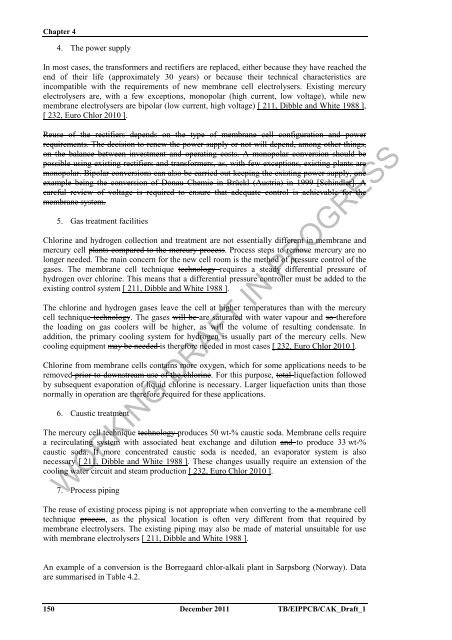(BAT) Reference Document for the Production of Chlor-alkali ...
(BAT) Reference Document for the Production of Chlor-alkali ...
(BAT) Reference Document for the Production of Chlor-alkali ...
Create successful ePaper yourself
Turn your PDF publications into a flip-book with our unique Google optimized e-Paper software.
Chapter 4<br />
4. The power supply<br />
In most cases, <strong>the</strong> trans<strong>for</strong>mers and rectifiers are replaced, ei<strong>the</strong>r because <strong>the</strong>y have reached <strong>the</strong><br />
end <strong>of</strong> <strong>the</strong>ir life (approximately 30 years) or because <strong>the</strong>ir technical characteristics are<br />
incompatible with <strong>the</strong> requirements <strong>of</strong> new membrane cell electrolysers. Existing mercury<br />
electrolysers are, with a few exceptions, monopolar (high current, low voltage), while new<br />
membrane electrolysers are bipolar (low current, high voltage) [ 211, Dibble and White 1988 ],<br />
[ 232, Euro <strong>Chlor</strong> 2010 ].<br />
Reuse <strong>of</strong> <strong>the</strong> rectifiers depends on <strong>the</strong> type <strong>of</strong> membrane cell configuration and power<br />
requirements. The decision to renew <strong>the</strong> power supply or not will depend, among o<strong>the</strong>r things,<br />
on <strong>the</strong> balance between investment and operating costs. A monopolar conversion should be<br />
possible using existing rectifiers and trans<strong>for</strong>mers, as, with few exceptions, existing plants are<br />
monopolar. Bipolar conversions can also be carried out keeping <strong>the</strong> existing power supply, one<br />
example being <strong>the</strong> conversion <strong>of</strong> Donau Chemie in Brückl (Austria) in 1999 [Schindler]. A<br />
careful review <strong>of</strong> voltage is required to ensure that adequate control is achievable <strong>for</strong> <strong>the</strong><br />
membrane system.<br />
5. Gas treatment facilities<br />
<strong>Chlor</strong>ine and hydrogen collection and treatment are not essentially different in membrane and<br />
mercury cell plants compared to <strong>the</strong> mercury process. Process steps to remove mercury are no<br />
longer needed. The main concern <strong>for</strong> <strong>the</strong> new cell room is <strong>the</strong> method <strong>of</strong> pressure control <strong>of</strong> <strong>the</strong><br />
gases. The membrane cell technique technology requires a steady differential pressure <strong>of</strong><br />
hydrogen over chlorine. This means that a differential pressure controller must be added to <strong>the</strong><br />
existing control system [ 211, Dibble and White 1988 ].<br />
The chlorine and hydrogen gases leave <strong>the</strong> cell at higher temperatures than with <strong>the</strong> mercury<br />
cell technique technology. The gases will be are saturated with water vapour and so <strong>the</strong>re<strong>for</strong>e<br />
<strong>the</strong> loading on gas coolers will be higher, as will <strong>the</strong> volume <strong>of</strong> resulting condensate. In<br />
addition, <strong>the</strong> primary cooling system <strong>for</strong> hydrogen is usually part <strong>of</strong> <strong>the</strong> mercury cells. New<br />
cooling equipment may be needed is <strong>the</strong>re<strong>for</strong>e needed in most cases [ 232, Euro <strong>Chlor</strong> 2010 ].<br />
<strong>Chlor</strong>ine from membrane cells contains more oxygen, which <strong>for</strong> some applications needs to be<br />
removed prior to downstream use <strong>of</strong> <strong>the</strong> chlorine. For this purpose, total liquefaction followed<br />
by subsequent evaporation <strong>of</strong> liquid chlorine is necessary. Larger liquefaction units than those<br />
normally in operation are <strong>the</strong>re<strong>for</strong>e required <strong>for</strong> <strong>the</strong>se applications.<br />
6. Caustic treatment<br />
The mercury cell technique technology produces 50 wt-% caustic soda. Membrane cells require<br />
a recirculating system with associated heat exchange and dilution and to produce 33 wt-%<br />
caustic soda. If more concentrated caustic soda is needed, an evaporator system is also<br />
necessary [ 211, Dibble and White 1988 ]. These changes usually require an extension <strong>of</strong> <strong>the</strong><br />
cooling water circuit and steam production [ 232, Euro <strong>Chlor</strong> 2010 ].<br />
WORKING DRAFT IN PROGRESS<br />
7. Process piping<br />
The reuse <strong>of</strong> existing process piping is not appropriate when converting to <strong>the</strong> a membrane cell<br />
technique process, as <strong>the</strong> physical location is <strong>of</strong>ten very different from that required by<br />
membrane electrolysers. The existing piping may also be made <strong>of</strong> material unsuitable <strong>for</strong> use<br />
with membrane electrolysers [ 211, Dibble and White 1988 ].<br />
An example <strong>of</strong> a conversion is <strong>the</strong> Borregaard chlor-<strong>alkali</strong> plant in Sarpsborg (Norway). Data<br />
are summarised in Table 4.2.<br />
150 December 2011 TB/EIPPCB/CAK_Draft_1







